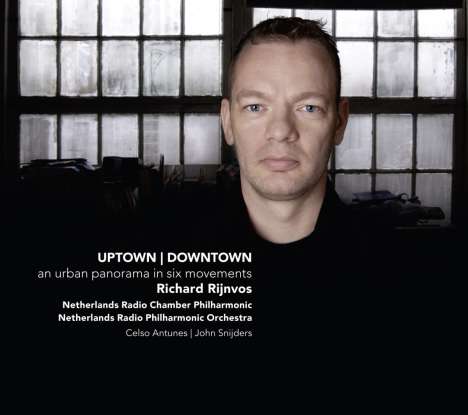Uptown/Downtown - An urban panorama in six movements auf CD
Uptown/Downtown - An urban panorama in six movements
Herkömmliche CD, die mit allen CD-Playern und Computerlaufwerken, aber auch mit den meisten SACD- oder Multiplayern abspielbar ist.
(soweit verfügbar beim Lieferanten)
NYConcerto für Klavier & Kammerorchester; Manhattan Square Dances für 2 identische Orchester
- Künstler:
- John Snijders, Netherlands Radio Chamber Philharmonic, Netherlands Radio Philharmonic Orchestra, Celso Antunes
- Label:
- Challenge
- Aufnahmejahr ca.:
- 2011
- Artikelnummer:
- 2737835
- UPC/EAN:
- 0608917253825
- Erscheinungstermin:
- 23.5.2012
Packende Neue Musik für Kammerorchester.
"Je weniger Ideen eine Komposition hat, desto stärker wird sie". Das ist eine Behauptung von Morton Feldman und auch eine Devise von Richard Rijnvos.
1964 in den Niederlanden geboren, studierte er Komposition bei Jan van Vlijmen und Brian Ferneyhough am Königlichen Konservatorium Den Haag und schloss eine Nachdiplom-Ausbildung in Freiburg im Breisgau an. In den Jahren 1986–1992 kam er in Berührung mit den amerikanischen Komponisten Morton Feldman und John Cage, was zu einer drastischen Neuorientierung seines Schaffens führte. Dazu gesellen sich deutliche Einflüsse nichtmusikalischer Art durch Künstler wie William Burroughs, Samuel Beckett, Joseph Beuys und Italo Calvino.
Richard Rijnvos erhielt zahlreiche Auszeichnungen, unter anderem den Perspektiefprijs 1989, eine ehrenvolle Erwähnung am Prix Italia 1991 für seine Hörspielproduktion Radio I nach einem Text von Samuel Beckett. und im Jahr 2000 den Matthijs-Vermeulen-Preis der Stadt Amsterdam für Times Square Dance. Im Sommer 2004 brachte HatHut Records die CD mit dem gesamten Block-Beuys-Zyklus heraus. Letztes Jahr bezeichnete eine internationale Jury das NYConcerto als “die beste im Jahr 2007 in den Niederlanden uraufgeführte Komposition” und sprach ihr den Buma-Kompositionspreis zu.
Product Information
Richard Rijnvos (1964) likes to listen to masters from previous centuries: Beethoven, Janáček and Sibelius are favourites. Still, there is a great difference between the Romantic composers’ methods and his. Rijnvos himself says: “The classical idea of a composer is that he has the music in his mind and puts it on paper. I have nothing in my mind, yet I still want to compose. I’m interested in music that arises when you put certain conditions together and then see what happens.”
From Rijnvos’ descriptive titles, usually referring to cities and other places, you would not suspect that his method is so radically abstract. However, he is a composer who generates tones from non-musical or numerical sources, such as chess boards or magic squares. Someone who also loves to endlessly pile single-voice lines on top of each other. That strict, “impersonal” method leads paradoxically enough to sensual works with a non-Dutch signature.
“The less ideas a composition has, the stronger it gets", this is a statement of Morton Feldman and this is a beloved motto of Rijnvos. One can not put him in a box because each composition opens new sound worlds for his listeners. With the utmost precision he works on his oeuvre that unfolds himself like one grand novel. The most of his works are linked together in a series. Rijnvos composes for solo instruments as well as for small ensembles. Besides that he composes for symphony and chamber orchestra.
Disk 1 von 1 (CD)
-
1 Nyconcerto
-
2 Nyconcerto
-
3 Nyconcerto
-
4 Manhattan Square Dances
-
5 Manhattan Square Dances
-
6 Manhattan Square Dances
Mehr von Richard Rijnvos







